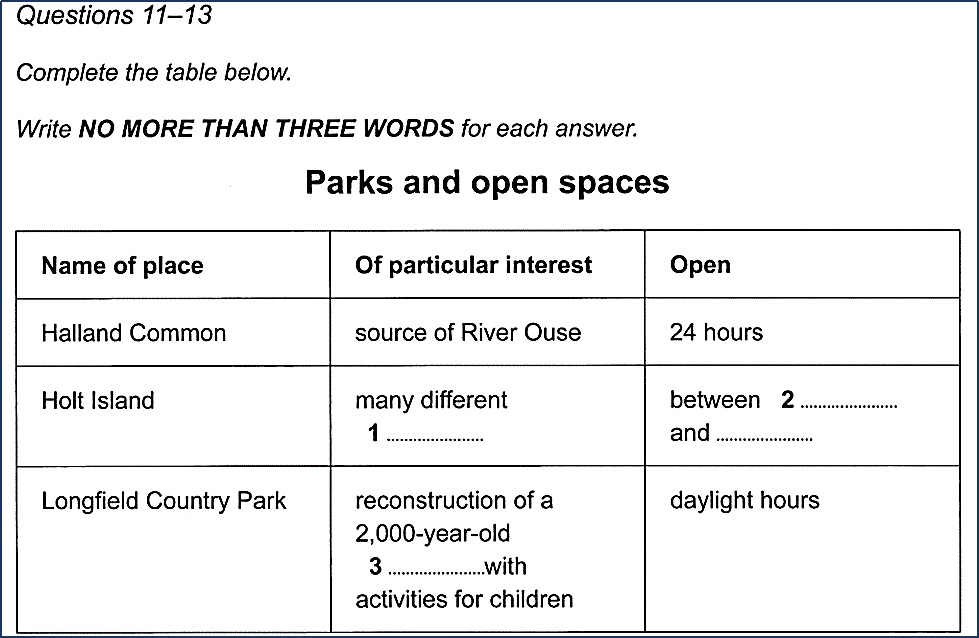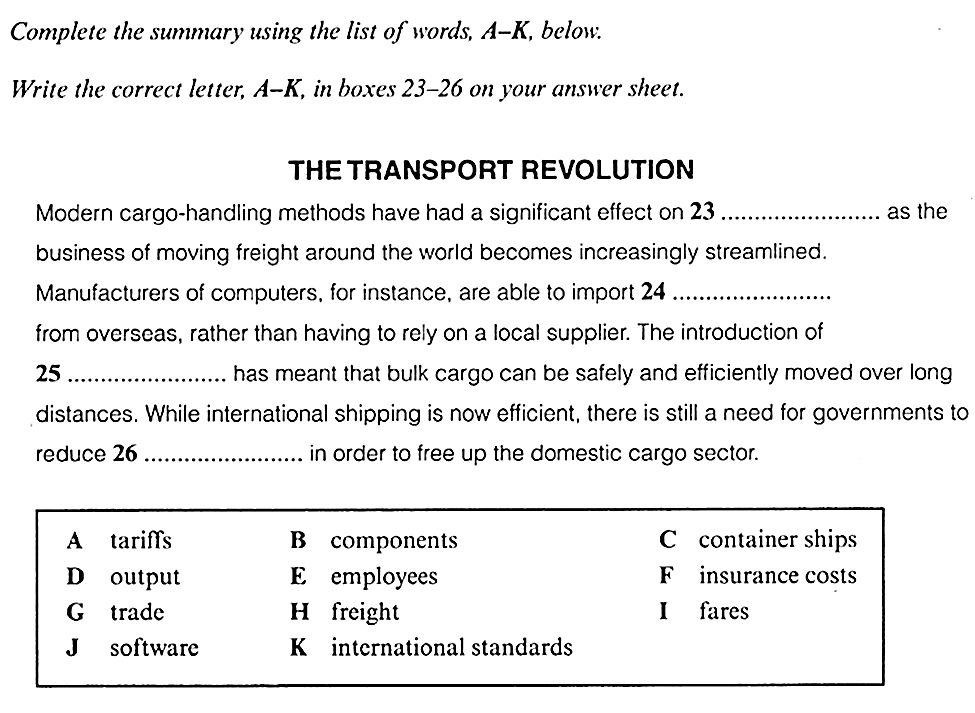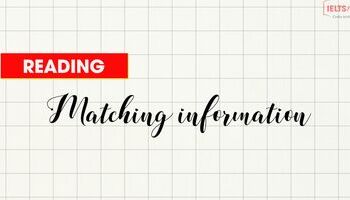Gap filling là gì?
Đây cũng là một dạng bài thường gặp trong bài thi IELTS Reading. Bạn sẽ được đọc một bài đọc và dùng thông tin trong bài đọc để điền vào bảng, biểu đồ, ghi chú … được cho.
Completing tables, charts, note, diagrams và summary là những tên khác gọi của dạng câu hỏi này, cách làm cũng tương tự nên trong bài này sẽ được tổng hợp chung để bạn áp dụng cho bài thi.
Format câu hỏi Gap filling
Dạng Completing tables (hoàn thành bảng)

Dạng Completing summary (hoàn thành đoạn tóm tắt)

Chú ý, trong dạng bài này sẽ có 2 loại bài:
Loại 1: Bạn chỉ được sử dụng từ vựng trong đoạn văn để điền vào chỗ trống. Bạn không được phép dùng ngôn ngữ của mình để điền vào (ảnh 1)
Loại 2: Dạng này sẽ cho bạn một list câu trả lời. Bạn cần đọc – hiểu đoạn văn cho sẵn sau đó dùng từ vựng được cho để điền vào chỗ trống phù hợp. (ảnh 2)
Lưu ý:
- Những từ được cho trong khung không phải nhất nhất phải giống các từ trong bài đọc.
- Phần tóm tắt có thể liên quan đến một phần hay toàn bộ bài đọc
- Phần tóm tắt sẽ theo trật tự của bài văn do đó mà bạn có thể yên tâm chọn.
- Những từ được cho trong khung có thể nhiều hơn số từ cần điền.
Các bước làm bài Gap filling
Bước 1: Đọc đề bài, xác định số lượng từ có thể điền
Choose NO MORE THAN TWO WORDS from the passage for each answer.
à Đề bài trên chỉ ra rằng, đáp án thí sinh cần điền chỉ có thể là 2 từ trở xuống.
Bước 2: Xác định keywords và từ loại của từ cần điền
Xác định keywords và từ loại của từ cần điền
Gạch chân keyword:
| Type of reader | Reading method | Effect of method on reader |
| Skilled reader | · many (1) ……. in a block · reader hardly ever goes back
| · reader’s (2) ……. do less work · more (3) …… is processed
|
| (4)…… | · Small blocks · Reader (5)…….. goes back
| · Reader easily gets (6)…….. · Finds it hard to (7)……. on passage
|
(1) từ cần điền sau many à loại từ cần điền là một danh từ
(2) từ cần điền sau một sở hữu cách à loại từ cần điền là một danh từ
(3) từ cần điền sau more và làm chủ ngữ à loại từ cần điền là một danh từ.
(4) Từ cần điền cùng cột với “skilled reader” nên cũng sẽ có dạng “Adj+N”
(5) Từ cần điền nằm sau chủ ngữ và trước động từ à loại từ cần điền có thể là một trạng từ
(6) Từ cần điền sau get à loại từ cần điền là tính từ. Ta có cấu trúc: Get + Adj
(7) Ta có cấu trúc find it adj to do something à loại từ cần điền là động từ
Bước 3: Đọc kỹ câu hỏi
xác định vị trí thông tin tương ứng trong bài đọc
Bài đọc:
A skilled reader will read a lot of words in each block. He or she will only look at each block for an instant and will then move on. Only rarely will the reader's eyes skip back to a previous block of words. This reduces the amount of work that the reader's eyes have to do. It also increases the volume of information that can be processed over a given period of time. On the other hand, a slow reader will spend a lot of time reading small blocks of words. He or she will often go back, losing the flow and structure of the text, and muddling their overall understanding of the subject. This irregular eye movement quickly makes the reader tired. Poor readers tend to dislike reading because they feel it is difficult concentrate and comprehend to written information.
Bước 4: Điền đáp án đúng
(1) words
(2) eyes
(3) information
(4) slow reader
(5) often
(6) tired
(7) concentrate
Bước 5: Kiểm tra
Sau khi điền xong thì kiểm tra lại ngữ pháp, dạng từ xem đã đúng hay chưa và có bị sai chính tả hay không.
Check lại ngữ pháp và chính tả, ta thấy các cụm từ, các câu đã đúng về mặt ngữ pháp: hòa hợp chủ vị, trật tự các loại từ, danh từ số nhiều/số ít …
Check- up 1
Complete the table below using information from the reading passage. Write NO MORE THAN THREE WORDS for each answer. Write your answers in boxes 1-8 on your answer sheet.
Lessons from the Titanic
A. From the comfort of our modern lives we tend to look back at the turn of the twentieth century as a dangerous time for sea travellers. With limited communication facilities, and shipping technology still in its infancy in the early nineteen hundreds, we consider ocean travel to have been a risky business. But to the people of the time it was one of the safest forms of transport. At the time of the Titanic’s maiden voyage in 1912, there had only been four lives lost in the previous forty years on passenger ships on the North Atlantic crossing. And the Titanic was confidently proclaimed to be unsinkable. She represented the pinnacle of technological advance at the time. Her builders, crew and passengers had no doubt that she was the finest ship ever built. But still she did sink on April 14, 1912, taking 1,517 of her passengers and crew with her.
B. The RMS Titanic left Southampton for New York on April 10, 1912. On board were some of the richest and most famous people of the time who had paid large sums of money to sail on the first voyage of the most luxurious ship in the world. Imagine her placed on her end: she was larger at 269 metres than many of the tallest buildings of the day. And with nine decks, she was as high as an eleven storey building. The Titanic carried 329 first class, 285 second class and 710 third class passengers with 899 crew members, under the care of the very experienced Captain Edward J. Smith. She also carried enough food to feed a small town, including 40,000 fresh eggs, 36,000 apples, 111,000 lbs of fresh meat and 2,200 lbs of coffee for the five day journey.
C. RMS Titanic was believed to be unsinkable because the hull was divided into sixteen watertight compartments. Even if two of these compartments flooded, the ship could still float. The ship’s owners could not imagine that, in the case of an accident, the Titanic would not be able to float until she was rescued. It was largely as a result of this confidence in the ship and in the safety of ocean travel that the disaster could claim such a great loss of life.
D. In the ten hours prior to the Titanic’s fatal collision with an iceberg at 11.40pm, six warnings of icebergs in her path were received by the Titanic's wireless operators. Only one of these messages was formally posted on the bridge; the others were in various locations across the ship. If the combined information in these messages of iceberg positions had been plotted, the ice field which lay across the Titanic’s path would have been apparent. Instead, the lack of formal procedures for dealing with information from a relatively new piece of technology, the wireless, meant that the danger was not known until too late. This was not the fault of the Titanic crew. Procedures for dealing with warnings received through the wireless had not been formalised across the shipping industry at the time. The fact that the wireless operators were not even Titanic crew, but rather contracted workers from a wireless company, made their role in the ship’s operation quite unclear.
E. Captain Smith’s seemingly casual attitude in increasing the speed on this day to a dangerous 22 knots or 41 kilometres per hour, can then be partly explained by his ignorance of what lay ahead. But this only partly accounts for his actions, since the spring weather in Greenland was known to cause huge chunks of ice to break off from the glaciers. Captain Smith knew that these icebergs would float southward and had already acknowledged this danger by taking a more southerly route than at other times of the year. So why was the Titanic travelling at high speed when he knew, if not of the specific risk, at least of the general risk of icebergs in her path? As with the lack of coordination of the wireless messages, it was simply standard operating procedure at the time. Captain Smith was following the practices accepted on the North Atlantic, practices which had coincided with forty years of safe travel. He believed, wrongly as we now know, that the ship could turn or stop in time if an iceberg was sighted by the lookouts.
F. There were around two and a half hours between the time the Titanic rammed into the iceberg and its final submersion. In this time 705 people were loaded into the twenty lifeboats. There were 473 empty seats available on lifeboats while over 1,500 people drowned. These figures raise two important issues. Firstly, why there were not enough lifeboats to seat every passenger and crew member on board. And secondly, why the lifeboats were not full.
G. The Titanic had sixteen lifeboats and four collapsible boats which could carry just over half the number of people on board her maiden voyage and only a third of the Titanic’s total capacity. Regulations for the number of lifeboats required were based on outdated British Board of Trade regulations written in 1894 for ships a quarter of the Titanic’s size, and had never been revised. Under these requirements, the Titanic was only obliged to carry enough lifeboats to seat 962 people. At design meetings in 1910, the shipyard’s managing director, Alexander Carlisle, had proposed that forty eight lifeboats be installed on the Titanic, but the idea had been quickly rejected as too expensive. Discussion then turned to the ship’s décor, and as Carlisle later described the incident … ’we spent two hours discussing carpet for the first class cabins and fifteen minutes discussing lifeboats’.
H. The belief that the Titanic was unsinkable was so strong that passengers and crew alike clung to the belief even as she was actually sinking. This attitude was not helped by Captain Smith, who had not acquainted his senior officers with the full situation. For the first hour after the collision, the majority of people aboard the Titanic, including senior crew, were not aware that she would sink, that there were insufficient lifeboats or that the nearest ship responding to the Titanic’s distress calls would arrive two hours after she was on the bottom of the ocean. As a result, the officers in charge of loading the boats received a very halfhearted response to their early calls for women and children to board the lifeboats. People felt that they would be safer, and certainly warmer, aboard the Titanic than perched in a little boat in the North Atlantic Ocean. Not realising the magnitude of the impending disaster themselves, the officers allowed several boats to be lowered only half full.
I. Procedures again were at fault, as an additional reason for the officers’ reluctance to lower the lifeboats at full capacity was that they feared the lifeboats would buckle under the weight of 65 people. They had not been informed that the lifeboats had been fully tested prior to departure. Such procedures as assigning passengers and crew to lifeboats and lifeboat loading drills were simply not part of the standard operation of ships nor were they included in crew training at this time.
J As the Titanic sank, another ship, believed to have been the Californian, was seen motionless less than twenty miles away. The ship failed to respond to the Titanic’s eight distress rockets. Although the officers of the Californian tried to signal the Titanic with their flashing Morse lamp, they did not wake up their radio operator to listen for a distress call. At this time, communication at sea through wireless was new and the benefits not well appreciated, so the wireless on ships was often not operated around the clock. In the case of the Californian, the wireless operator slept unaware while 1,500 Titanic passengers and crew drowned only a few miles away.
K After the Titanic sank, investigations were held in both Washington and London. In the end, both inquiries decided that no one could be blamed for the sinking. However, they did address the fundamental safety issues which had contributed to the enormous loss of life. As a result, international agreements were drawn up to improve safety procedures at sea. The new regulations covered 24 hour wireless operation, crew training, proper lifeboat drills, lifeboat capacity for all on board and the creation of an international ice patrol.
| Problem | Cause of the problem | Regulated after the Titanic disaster? |
| Position of icebergs not plotted | (1) ......... scattered all over the ship | Doesn’t say |
| Insufficient lifeboats | (2) ......... regulations | (3) ......... |
| Lifeboats not full | a) ignorance of the extent of the danger b) fear that the lifeboats would (4) ......... | (5) .........
(6) ......... |
| Californian didn’t listen to the distress calls | No (7)......... wireless operation | (8) ......... |
Các mẹo làm bài
Mẹo 1: Hiểu rõ câu hỏi đang hỏi bạn thuộc dạng điền từ nào để điền chính xác
Mẹo 2: Đọc bài và hiểu ý chính của bài đọc. Bạn nên tách biệt phần tóm tắt và phần văn bản để không bị nhầm lẫn.
Mẹo 3: Kỹ năng cần có là Skim và Scan – đọc lướt và tìm ý nghĩa chính. Đây là kỹ năng cần thiết đối với bài đọc nào. Bạn sẽ đoán được đáp án đúng nhiều hơn.
Mẹo 4: Chú ý từ đồng nghĩa, gần nghĩa vì các từ trong đoạn tóm tắt sẽ khác so với các từ trong bài đọc.
Mẹo 5: Học ngữ pháp thật chuẩn. Bởi ngữ pháp là phần quan trọng trong dạng bài này bởi mỗi từ bạn chọn cần đúng ngữ pháp, xác định đúng loại từ…thì có thể giúp bạn suy ra đáp án đúng nhanh hơn đó.
Mẹo 6: Bài đọc này, bạn không cần đọc hết bởi phần thông tin điền từ thường nằm trong một đoạn văn mà không dàn trải, xác định được đoạn văn này và đọc kỹ là được.
Mẹo 7: Câu trả lời sẽ không theo thứ tự như câu hỏi nên bạn cần tìm key và làm bài chứ không đọc theo thứ tự.
Mẹo 8: Dạng câu hỏi lấy thông tin từ bài đọc thì từ vựng thường sẽ được cho sẵn trong đoạn văn chứ không phải tự nghĩ hoặc chia động từ/cho dạng đúng của từ nên nếu tìm được từ cần điền thì bạn phải ghi vào trong phần answer sheet của mình luôn. Nhưng như đã nói, bạn cần chú ý đến ngữ pháp để điền từ bởi trong một số trường hợp, bài thi cần thay đổi từ cần điền.
Check- up 2
Sample Academic Reading Summary Completion (selecting words from the text)
[Note: This is an extract from a Part 3 text about the ‘Plain English’ movement, which promotes the use of clear English.]
‘The Cambridge Encyclopedia of Language’, David Crystal, 3rd Edition, © Cambridge University Press, 2010.
The instructions accompanying do-it-yourself products are regularly cited as a source of unnecessary expense or frustration. Few companies seem to test their instructions by having them followed by a first-time user. Often, essential information is omitted, steps in the construction process are taken for granted, and some degree of special knowledge is assumed. This is especially worrying in any fields where failure to follow correct procedures can be dangerous.
Objections to material in plain English have come mainly from the legal profession. Lawyers point to the risk of ambiguity inherent in the use of everyday language for legal or official documents, and draw attention to the need for confidence in legal formulations, which can come only from using language that has been tested in courts over the course of centuries. The campaigners point out that there has been no sudden increase in litigation as a consequence of the increase in plain English materials.
Similarly, professionals in several different fields have defended their use of technical and complex language as being the most precise means of expressing technical or complex ideas. This is undoubtedly true: scientists, doctors, bankers and others need their jargon in order to communicate with each other succinctly and unambiguously. But when it comes to addressing the non-specialist consumer, the campaigners argue, different criteria must apply.
Questions 1 – 5: Complete the summary below. Choose NO MORE THAN TWO WORDS from the passage for each answer. Write your answers in boxes 1-5 on your answer sheet.
Consumers often complain that they experience a feeling of 1 ………… when trying to put together do-it-yourself products which have not been tested by companies on a 2 ………… . In situations where not keeping to the correct procedures could affect safety issues, it is especially important that 3 ………… information is not left out and no assumptions are made about a stage being self-evident or the consumer having a certain amount of 4 ………… . Lawyers, however, have raised objections to the use of plain English. They feel that it would result in ambiguity in documents and cause people to lose faith in 5 ………… , as it would mean departing from language that has been used in the courts for a very long time.
Luyện tập có đáp án
PASSAGE 1
The nature of Yawning
A. While fatigue, drowsiness or boredom easily bring on yawns, scientists are discovering there is more to yawning than most people think. Not much is known about why we yawn or if it serves any useful function. People have already learned that yawning can be infectious. “Contagious yawning” is the increase in likelihood that you will yawn after watching or hearing someone else yawn, but not much is known about the under-lying causes, and very little research has been done on the subject. However, scientists at the University of Albany, as well as the University of Leeds and the University of London have done some exploration.
B. It is commonly believed that people yawn as a result of being sleepy or tired because they need oxygen. However, the latest research shows that a yawn can help cool the brain and help it work more effectively, which is quite different from the popular belief that yawning promotes sleep and is a sign of tiredness. Dr. Andrew Gallup and his colleagues at the University of Albany in New York State said their experiments on 44 students showed that raising or lowering oxygen and carbon dioxide levels in the blood did not produce that reaction. In the study participants were shown videos of people laughing and yawning, and researchers counted how many times the volunteers responded to the “contagious yawns”. The researchers found that those who breathed through the nose rather than the mouth were less likely to yawn when watching a video of other people yawning. The same effect was found among those who held a cool pack to their forehead, whereas those who held a warm pack yawned while watching the video. Since yawning occurs when brain temperature rises, sending cool blood to the brain serves to maintain the best levels of mental efficiency.
C. Yawning is universal to humans and many animals. Cats, dogs and fish yawn just like humans do, but they yawn spontaneously. Only humans and chimpanzees, our closest relatives in the animal kingdom, have shown definite contagious yawning. Though much of yawning is due to suggestibility, sometimes people do not need to actually see a person yawn to involuntarily yawn themselves: hearing someone yawning or even reading about yawning can cause the same reaction.
D. However, contagious yawning goes beyond mere suggestibility. Recent studies show that contagious yawning is also related to our predisposition toward empathy— the ability to understand and connect with others’ emotional states. So empathy is important, sure, but how could it possibly be related to contagious yawning? Leave it up to psychologists at Leeds University in England to answer that. In their study, researchers selected 40 psychology students and 40 engineering students. Generally, psychology students are more likely to feel empathy for others, while engineering students are thought to be concerned with objects and science. Each student was made to wait individually in a waiting room, along with an undercover assistant who yawned 10 times in as many minutes. The students were then administered an emotional quotient test: students were shown 40 images of eyes and asked what emotion each one displayed. The results of the test support the idea that contagious yawning is linked to empathy. The psychology students—whose future profession requires them to focus on others—yawned contagiously an average of 5.5 times in the waiting room and scored 28 out of 40 on the emotional test. The engineering students—who tend to focus on things like numbers and systems—yawned an average of 1.5 times and scored 25.5 out of 40 on the subsequent test. The difference doesn’t sound like much, but researchers consider it significant. Strangely enough, women, who are generally considered more emotionally attuned, didn’t score any higher than men.
E. Another study, led by Atsushi Senju, a cognitive researcher at the University of London, also sought to answer that question. People with autism disorder are considered to be developmentally impaired emotionally. Autistics have trouble connecting with others and find it difficult to feel empathy. Since autistics have difficulty feeling empathy, then they shouldn’t be susceptible to contagious yawning. To find out, Senju and his colleagues placed 49 kids aged 7 to 15 in a room with a television. 24 of the test subjects had been diagnosed with autism spectrum disorder, the other 25 were non-autistic kids. The test subjects were shown short clips of people yawning as well as clips of people opening their mouths but not yawning. While the kids with autism had the same lack of reaction to both kinds of clips, the non-autistic kids yawned more after the clips of people yawning.
F. There also have been studies that suggest yawning, especially psychological “contagious” yawning, may have developed as a way of keeping a group of animals alert and bonding members of a group into a more unit one. If an animal is drowsy or bored, it may not be as alert as it should to be prepared to spring into action and its yawning is practically saying, “Hey, I need some rest, you stay awake”. Therefore, a contagious yawn could be an instinctual reaction to a signal from one member of the herd reminding the others to stay alert when danger comes. So the theory suggests evidence that yawning comes from the evolution of early humans to be ready to physically exert themselves at any given moment.
Complete the summary below.
Choose ONE WORD from the passage for each answer.
Write your answers in boxes 10-13 on your answer sheet.
Another theory shows that yawning is used for 10................... individuals into a tighter social unit. Alternatively, yawning can help increase alertness of group members in case 11 ................... is close. For example, yawning signals that a member of the group needs some 12 ................... and requires the others to stay aware of the surrounding situation. This theory proves that yawning is only a spontaneous behaviour resulting from some part of a simple 13................... system in early humans.
Đáp án chi tiết
Check-up 1
(1) Ice warnings/ wireless messages
(2) out dated / out of date
(3) Yes
(4) Buckle
(5) Doesn’t say
(6) Yes
(7) 24 hour
(8) Yes
Check-up 2
1. frustration
2. first-time user
3. essential
4. special knowledge
5. legal formulations
PASSAGE 1
(Từ câu 10 – 13, các đáp án đều nằm ở đoạn văn cuối cùng trong bài)
- Đáp án: bonding
Chúng ta rút ra được từ này trong câu văn “There also have been studies that suggest yawning, especially psychological “contagious” yawning, may have developed as a way of keeping a group of animals alert and bonding members of a group into a more unit one”.
- Đáp án: danger
Chúng ta rút ra được từ này trong câu văn “Therefore, a contagious yawn could be an instinctual reaction to a signal from one member of the herd reminding the others to stay alert when danger comes”.
- Đáp án: rest
Chúng ta rút được từ này trong câu văn “If an animal is drowsy or bored, it may not be as alert as it should to be prepared to spring into action and its yawning is practically saying, ‘Hey, I need some rest, you stay awake”.
- Đáp án: evolution
Chúng ta rút được từ này trong câu văn “So the theory suggests evidence that yawning comes from the evolution of early humans to be ready to physically exert themselves at any given moment”.
Các bạn đã hoàn tất bài làm chưa? Nhớ cách làm và cùng luyện tập nha.
Xem thêm các dạng bài khác:
IELTS Reading: Chiến lược làm bài SHORT ANSWER QUESTION
IELTS Reading: Chiến thuật làm bài MATCHING HEADINGS
Bài phân tích đề thi thật, thực hiện bởi IELTS Fighter, vui lòng ghi nguồn nếu sử dụng chia sẻ. Xin cảm ơn.





